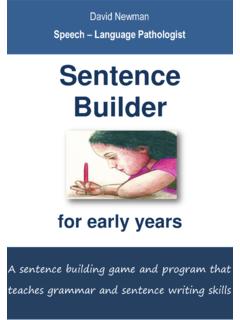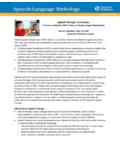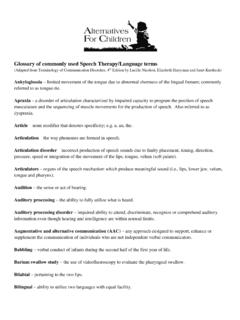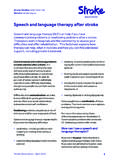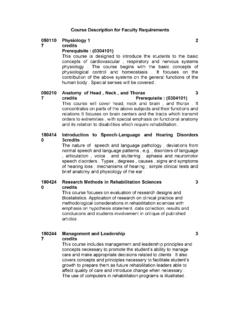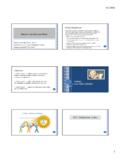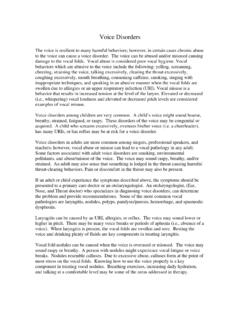Transcription of “TalkTools Oral Placement Therapy for Feeding and Speech”
1 talktools oral Placement Therapy for Feeding and speech Presented by Helen Woodrow BSc(Hons) cert MRCSLT MASLTIP HPCregIndependent speech and Language Presentation Outline Background talktools v. oral Motor Therapy talktools ' place in the SLT world Application of talktools Underlying Principles talktools OPT How does it work? Evidence based practice The future Background Sara Rosenfeld-Johnson SLP in America Started working in this field in 1973 Sara developed her own techniques in conjunction with OTs and Physios. Used for both Feeding and speech difficult to separate these two. The talktools approach is only a small part of any comprehensive programme for speech and / or Feeding . oral Motor Therapy v. talktools oral Placement TherapyOral Motor Therapy is an umbrella term that covers many different oral Placement Therapy is one specific type of oral Motor Therapy .
2 talktools ' place in the SLT World talktools OPT is another tool in the SLT repertoire and is not meant to replace other Therapy approaches. It is not designed to be used alone and is often used to work on underlying motor and sensory difficulties before other speech or Feeding approaches are introduced. Application of talktools OPT Appropriate for anyone displaying reduced mobility, agility, precision and endurance of the oral structures and musculature that adversely affects Feeding and / or speech . Downs Syndrome Autistic Spectrum Disorders Cerebral Palsy Head injury / stroke Dyspraxia / Dysarthria. Application of talktools OPTFor people who cannot imitate targeted movements using auditory and visual stimuli Look, listen and do what I do For people who cannot follow specific instructions to produce targeted movements Put your lips together For people who need a more tactile approach Underlying Principles of talktools OPT.
3 Three main concepts affecting movements of the jaw, lips and tongue are considered in talktools activities: Dissociation Grading Fixing These concepts underlie the oral movements necessary for Feeding and speech . DissociationThe separation of movement , based on adequate strength and stability in two or more muscle groups GradingThe controlled segmentation of movement based upon dissociation, strength and stability within the targeted muscle group. FixingAn abnormal movement pattern which occurs secondary to reduced stability and is used to compensate for the lack of grading within a muscle group. Underlying Principles of talktools OPT. talktools OPT takes a bottom up approach. Tongue Lips Jaw Underlying Principles of talktools OPT. Word level skills Single Sounds oral motor skills Underlying Principals of talktools OPT Bottom up approach, works on foundations for Feeding and speech oral placements training and practice Motor planning - training and practice Sensory awareness and feedback Whole body approach Tactile, visual and auditory feedback talktools OPT How does it work?
4 Assessment by a talktools trained therapist to look at Placement , motor and sensory difficulties. Hierarchy of activities that can be used by parents and carers to target Placement ,motor and sensory difficulties. Continuing programme lead by a talktools trained therapist. Programmes are based on clear and functional outcomes with measurable criteria for success. talktools OPT How does it work? Bubble hierarchy Step 1 Pop the bubble on lipsGoals Develop awareness of sensation on lips as a prerequisite for lip closure for Feeding , saliva control and Achieve lip closure from an open mouth posture- Build understanding of cause and effectCriteria for success client can pop the bubble using lip rounding and protrusion 10x talktools OPT How does it work?
5 Step 2 Breath or blow on the bubbleGoals Associate abdominal exhalation with movement of bubble. - Develop controlled airflow for phoneme production - Develop jaw lip dissociationCriteria for success Client can complete exercise 10x without a break talktools OPT How does it work? Step 3 Blow the bubble off the wandGoals Improve controlled airflow volume - Work on jaw lip dissociation - Develop strength and stability in orbicularis-oris muscles for lip roundingCriteria for success Client can repeat exercise 10x successfully without a break talktools OPT How does it work? Step 4 Blow a bubble through the wandGoals Improve controlled, elongated airflow - Work on jaw lip dissociation - Improve lip rounding skillsCriteria for success client can blow bubbles 10x in this position without support, without a break talktools OPT How does it work?
6 Step 5 Blow bubbles for increasing distancesGoals Improved controlled, elongated airflow - Develop jaw stability- Achieve jaw lip dissociation- Develop lip rounding / protrusion skills- Develop tongue retraction skills- Develop jaw lip tongue dissociation skillsEach step can be further task analysed into smaller steps if needed. Example Sensory Motor Programme for Feeding and SpeechMassageSuggestions:Sensory BeanbagsBare handsLotionFace flannelVibrationUse firm long From the TMJ (in front of ears) to the corners of G's Alongside the nostrils to the outer corners of the Under the nostrils to the upper each set 5 timesIncrease sensory awareness and organisationEncourage midline orientationFacilitate increased cheek and upper lip and ToneFingers or other suitable itemUse firm rhythmic tapping to the beat of a favourite tune or finger play From the TMJ (in front of ears) to the corners of G's On the surface of the sensory the muscles of the cheeks and can also use these firm tapping movements when wiping G's face.
7 Jaw routine 1. Jaw rockPhysio ballSit on the ball with G on your lap. Bounce gently to create a rhythmic up and down movement. Provide lip / jaw support and map the rhythmic movements onto G's jaw so that his jaw is moving up and down. Try to achieve 10 graded jaw chewy tubesTwo red chewy tubesPut the two chewy tubes in G's mouth, one on each side, on his first molars. The tubes should stick out sideways from his mouth. Instruct G to do 5 slow bites using a regular rhythm. Jaw support may be needed. Increase jaw jaw tongue retractionIncrease graded routine3. Stuffed chewy tubeRed chewy tubeChip sticks or pureeStuff a red chewy tube with a chip stick or some puree. Present the tube on one side of G's mouth as for previous exercise. Provide jaw support as needed.
8 Instruct G to do 3 chews. Swap to the other side and lateral chew. Lip routine1. Upper lip stretchZ vibe with yellow trimmed toothbrush with small the Z vibe yellow head under G's top lip and roll from the outside corner to the middle. Stop. Repeat on the other side. Do this 5 sensory upper lip routine2. Micky mouse /m/Z vibe and mouse headPresent Micky's ear between G's lips and model a /m/ sound. Encourage G to copy you and close his lips on Micky's 6 timesProvide sensory inputIncrease lip routine3. Cheek toning / lip roundingZ vibe with green cylinder shaped headPresent the rounded z vibe head between G's lips. Provide jaw / lip support as needed to facilitate lip rounding. Model a /w/ sound and encourage G to copy. Repeat 10 times.
9 Provide sensory inputFacilitate increase tone in lip rounding. Tongue routine1. Lateral tongue to tongue tipBite block #6Z vibe with small green square headUse the bite block to stabilize G's jaw by asking him to bite on it. Stroke along the side if G's tongue from front to back using the Z vibe. As you approach the front, press sideways to encourage the tongue tip to point and move across the midline. Do this 5 times. Repeat on the other sensory tongue elongationFacilitate tongue tip formation Facilitate tongue routine2. Chewing(pre Feeding chewing hierarchy level 2)Z vibe with small green square headPlace z vibe on G's outermost front tooth (lateral incisor) and encourage G to bite. Move back to his canine tooth, then to his first molar. Do this pattern 5 times and then repeat on the other sensory tongue tip graded tongue lateral chewTongue routine3.
10 Syringe feedingSmall syringe ( no needle!)Favourite pureeSqueeze 1-2ml of a favourite puree in to the cheek cavity. This should be between the cheek and the gum at about the level of the first molar. Provide jaw / lower lip support. Repeat 4 times on each tongue lateralizationIncrease tongue retraction. Feeding routine1. Honey bearHoney bear with favourite juice or water Present honey bear tube in the corner of G's lips and squeeze a small amount of liquid into his mouth. When G closes his lips. Move the tube to the midline and squeeze again. Repeat alternating starting 5 times on each lip roundingFacilitate suckFeeding routine2. Chewing hierarchy level with frozen puree in them, or chip stick, or choc finger, or chew food on first molar. Keep hold of the other end.
